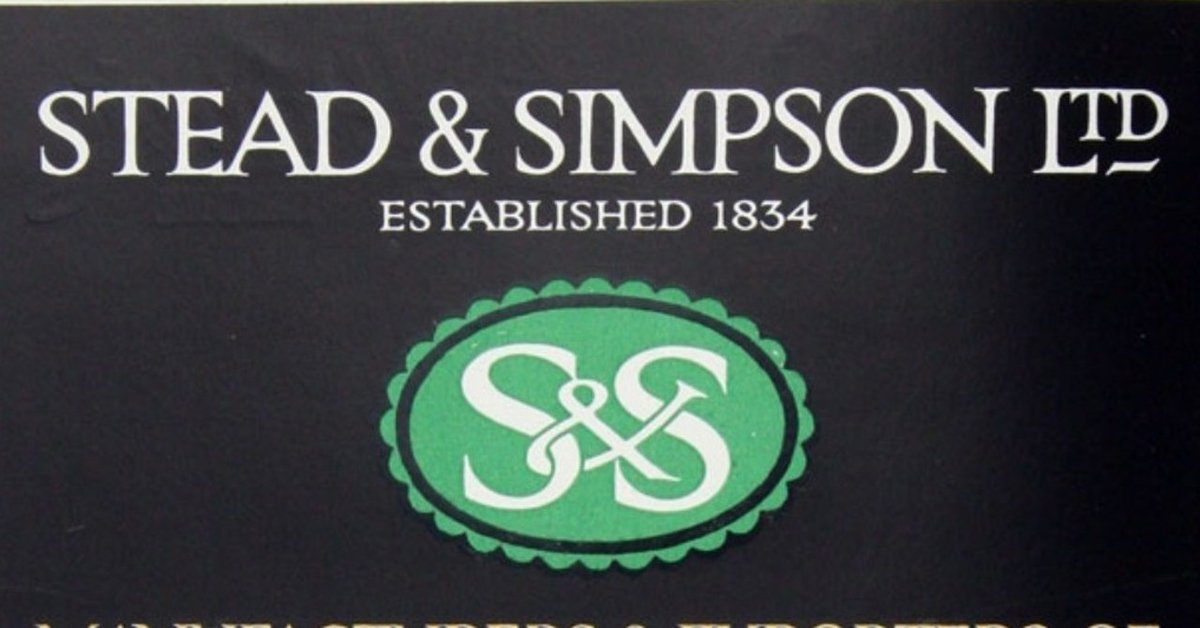
BUILT TO LAST: STEAD & SIMPSON
BUILT TO LAST: STEAD & SIMPSON

Stead, Simpson & Nephews was the largest footwear manufacturer in the world.
Establishment of the business
Edmund Stead (1803 – 1881) of Darlington and Morris Simpson (1808 – 1888) of Leeds established a curriers shop, to process leather for shoemaking, on Kirkgate, Leeds in 1834. Boots were manufactured from around 1840.
Edward Simpson (1819 – 1904), brother to Morris, later joined the partnership. He was possessed of good judgement and a sound business mind. He was a genial, likeable man who stood over six feet tall. A keen Wesleyan Methodist, he was a Radical in politics.
Morris Simpson left the partnership in 1844 in order to establish his own shoemaking business.
Problems in sourcing sufficient skilled labour led the firm to open a branch factory at London Road, Daventry in 1844.
Currier work began in Leicester from 1853, initially at Cank Street, before relocating to Belgrave Gate.
Stead & Simpson was best known for the manufacture of footwear by 1855. The firm employed 314 workers in 1861.
Two nephews enter the firm
Stead and Simpson each introduced a nephew to the business in 1863; Henry Simpson Gee (1842 – 1924) became the factories manager, and Richard Fawcett (1828 – 1889) was enlisted as a salesman.
Gee constructed new factories and was a pioneer in the introduction of steam-powered machinery in shoe and boot manufacture. He was a man of clear vision and gifted with an immensely practical nature.
The growth of business saw a new factory erected at New Street, Daventry in 1866.
The first retail shops were opened in the early 1870s. The earliest branches were at Carlisle, Whitehaven, South Shields and Sunderland.
The largest footwear manufacturer in the world
Stead, Simpson & Nephews was the largest footwear manufacturer in the world by 1875. The firm employed 1,216 workers in Leicester, 505 at Leeds, 500 at Daventry, 100 at Northampton and 80 at Oakham. 25,000 to 30,000 pairs of shoes and boots could be produced each week, including 5,600 pairs in Leeds.
Company headquarters had been relocated to Leicester by 1884. Joseph Griffin Ward (1843 – 1915) and John Lipson Ward (1847 – 1926) entered the business as partners.
There were retail shops in fifty towns across Britain by 1884. Over 3,000 workers produced over 30,000 pairs of boots and shoes each week.
The Leicester factory at Belgrave Gate was destroyed by fire in 1886, with damaged estimated at £36,000. 1,500 people were temporarily thrown out of employment.
Conversion of the business into a public company
Edward Simpson, the senior partner, retired in 1887. Following the death of Richard Fawcett in 1889, the firm became too large for the remaining partners, and was converted into a public limited liability company, Stead & Simpson, with a capital of £300,000. The entire business, including goodwill, was valued at £268,000. The head office was located on Belgrave Gate, Leicester.
Henry Simpson Gee was the senior partner, and he became company chairman. J G Ward and J L Ward, the other two partners, were appointed as joint managing directors. Edward Wood (1839 – 1917), the chairman of Freeman Hardy & Willis , shoe retailers and manufacturers of Leicester, also joined the board.
There were about 100 retail shops by 1889. The Leeds tanning and currying business was discontinued from 1892, and the capital was utilised to extend the retail arm of the business.
Harry Percy Gee (1874 – 1962), the son of Henry Simpson Gee, joined the board of directors from 1898. He was subsequently appointed managing director.
Henry Simpson Gee was raised as a Wesleyan Methodist, but switched to Anglicanism in his later years. He died in 1924 with an estate valued at £659,699. He died as one of the best known businessmen in the Midlands. His largest charitable bequest was £20,000 to Leicester College, later the University of Leicester. He was succeeded as company chairman by Harry Percy Gee.
There were 250 retail shops by 1934, including 115 freehold leases, with a total value of around £500,000. There were 1,067 factory workers, 168 warehouse and clerical staff and 1,130 shop managers and assistants, a total staff of 2,365.
Harry Percy Gee retired as managing director in 1958, but remained as chairman until his death in 1962. His obituary in The Times heralded him as the “greatest benefactor the University [of Leicester] ever had”, and it was his generosity in the 1930s that enabled its survival. Gee left a net estate of £484,771.
Stead & Simpson owned 223 retail branches by 1963.
The company branched out into car dealerships in the Leicestershire area from 1966.
End of shoemaking, and demise of the business
Stead & Simpson closed its shoe manufacturing operations in Daventry and Leicester in 1973 with the loss of 400 jobs. The company announced that it would concentrate on its retail business of over 200 shops.
UDS Group acquired 16 percent of the company in 1974. Hanson Trust acquired UDS Group in 1983, and with it control of 29.1 percent of voting shares in Stead & Simpson.
The shoe retailer Ward White acquired the 29.1 percent voting stake in Stead & Simpson from Hanson Trust for just under £2 million in 1984. By this time the company had 240 shoe shops.
Ward White sold its stake to Tozer Kemsley and Millbourn for £3.6 million in cash in 1987.
Stead & Simpson was acquired by Clayform Properties for £120 million in cash in 1989.
Stead & Simpson was bought out by its management for £50 million in 2005. By this time the firm had around 400 stores.
Stead & Simpson entered administration in 2008. It was acquired by Shoe Zone of Leicester. 309 stores were retained, whilst 37 were closed. A further 90 shops were closed in 2012.
世界中の靴の歴史を研究をしています。ご協力いただければ嬉しいです。よろしくお願いいたします。
